 DA40 XLS: The Innovator Keeps Getting Better
DA40 XLS: The Innovator Keeps Getting Better
Written by Marc C. Lee, AIr-To-Air Photos By Jessica AmbatsWith the addition of Garmin’s Synthetic Vision Technology and other improvements, the popular composite four-seater reaches a wider audience
The day was a dappled gray when I arrived at Long Beach Airport in California for my chance to fly the brand-new Diamond DA40 XLS. Rain had been forecast for the afternoon, but the thin overcast had given way to broken clouds with a deep blue sky peering from behind them. Morning rain had washed the air clean, and the light winds made it a perfect day to fly.
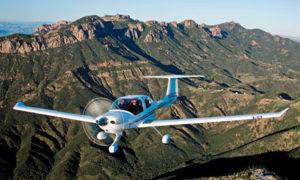
So much has been written about Diamond and the DA40 that I wanted to do something different. Instead of merely putting the airplane through a repertoire of aerial tasks, I decided to fly the XLS like an everyday pilot and take the futuristic-looking craft on a little cross-country. My partner would be Robert Stewart, territory manager and demo pilot for USAERO, an authorized Diamond distributor for the Southwestern United States.
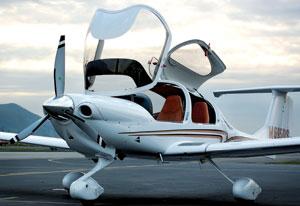 The Diamond story should be well-known by now. The company began as a motor-glider manufacturer in Austria in 1981. Acquired by the Dries family in 1991, the company started producing the HK36R Rotax-powered motor glider and its derivative, the DV20 “Katana,” that same year. The two-seat Katana was certified in the United States in 1993, and Diamond (then called “Dimona”) established a large-scale manufacturing facility in London, Ontario, Canada. After much success in the States and internationally, Diamond announced the DA40 in 1997.
The Diamond story should be well-known by now. The company began as a motor-glider manufacturer in Austria in 1981. Acquired by the Dries family in 1991, the company started producing the HK36R Rotax-powered motor glider and its derivative, the DV20 “Katana,” that same year. The two-seat Katana was certified in the United States in 1993, and Diamond (then called “Dimona”) established a large-scale manufacturing facility in London, Ontario, Canada. After much success in the States and internationally, Diamond announced the DA40 in 1997.
From the beginning, Diamond has been a pioneer and innovator in areas like composite construction and safety testing; it served as the launch platform for Garmin’s G1000 glass panel. The new DA40 XLS is part of a family of ingenious airplanes that includes the DA20, the DA42 twin-engine aircraft (with choice of diesel or Lycoming engines), the FADEC-controlled, five-seat, pressurized DA50 and the much-anticipated D-JET.
It’s important to note that this XLS is a far different airplane from the DA40 that was certified a decade ago. The original had a different propeller and exhaust system and a lower gross weight, as well as subtle differences like different speed fairings and larger tires. Diamond has learned from each model and has evolved the DA40 with hundreds of improvements, large and small. Those who flew the DA40 in years past and think they know the airplane might be very surprised.
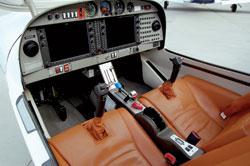
The cabin of the DA40 XLS features a sports car–like interior with a center-stick design that appears to grow out of the seats
Stewart walked me out to the immaculate hangar where the freshly polished DA40 sat, looking not unlike an alien craft with its teardrop fuselage, wingtips and bubble canopy. We spent a long while peering around the XLS, with Stewart demonstrating obvious things like the unique center-stick design that seems to grow out of the seats and interesting features like the “safety cell” structure around the cabin and the BMW-like interior.
Climbing into the DA40, the first thing that everybody notices is the visibility. I had flown airplanes with good visibility before, but this surpassed them all. Lack of windshield support posts or divisions, combined with a low sill height, gives the cockpit an IMAX theater feel. The ample rear windows and gull-wing rear passenger door prevent the claustrophobic feel of many passenger compartments.
Standard in the XLS are front air-bag seat belts. The seats aren’t adjustable, and my 5’7” stature could have used another inch or two of support to see over the panel. One nice feature that wasn’t on the older DA40s is the electric rudder-pedal adjustment. The range of motion is impressive, and I think even my nine-year-old could reach these with the flick of a switch.
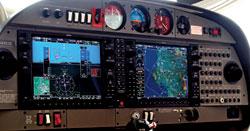
The aircraft is equipped with Garmin’s G1000 glass panel, and Synthetic Vision Technology offers a 3-D view of surrounding terrain and potential obstacles.
Starting the engine didn’t yield anything esoteric, so we fired up the Garmin G1000 to put in our flight plan. The DA40 XLS comes standard with the G1000 with satellite data link, WAAS, TAWS-B, a GFC 700 autopilot with flight director, SafeTaxi, FliteCharts and a GTX 33 transponder with TIS traffic. This particular XLS also had new Garmin Synthetic Vision Technology (SVT). It was astonishing to know that this four-seat aircraft had more technological capability than most modern airliners.
Because this was to be a typical mission, we decided to fly 55 nm to Santa Paula Airport to mingle with the taildraggers and grab some dinner. Santa Paula is a sort of haven for classic aircraft, and we thought it might be good to see how the Diamond would stack up in such a rough-and-tumble environment.
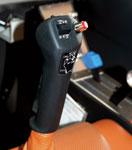 Cleared for takeoff, I lifted the nose at 63 knots and headed toward the ocean. “Climb at about 80,” suggested Stewart as I awkwardly tried the electric trim on the stick. “I like to use the manual trim so I can feel the airplane,” he smiled, and I welcomed the sight of the trim wheel under my arm on the center console. We showed an easy 1,050 fpm climb on the PFD at 80 knots. Around me, the panorama of flight through the wraparound windshield unfolded like a Cecil B. DeMille film. You sit ahead of the wing on the XLS, so you experience the benefits of a high-wing airplane’s downward visibility, along with the clear turns and skyward view of a low-wing.
Cleared for takeoff, I lifted the nose at 63 knots and headed toward the ocean. “Climb at about 80,” suggested Stewart as I awkwardly tried the electric trim on the stick. “I like to use the manual trim so I can feel the airplane,” he smiled, and I welcomed the sight of the trim wheel under my arm on the center console. We showed an easy 1,050 fpm climb on the PFD at 80 knots. Around me, the panorama of flight through the wraparound windshield unfolded like a Cecil B. DeMille film. You sit ahead of the wing on the XLS, so you experience the benefits of a high-wing airplane’s downward visibility, along with the clear turns and skyward view of a low-wing.
It’s impossible to report on the DA40 without talking about safety. Safety is a hallmark for Diamond, and the company’s development in this area is impressive. The NTSB’s raw data confirms the undeniable fact that Diamond makes aircraft that are safe by design. I decided to do some research on my own to confirm the manufacturer’s numbers. The evidence is quite compelling. According to the NTSB, since 1998 when the DA40 was introduced, there have been only two fatal accidents involving the DA40. In fact, in the past 11 years, there have been only eight total accidents involving the DA40. The two fatal accidents were attributed to “buzzing” a boat at night and to hitting power lines on an approach to minimums.
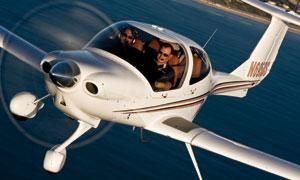
The aircraft’s cockpit offers an open feel and superb visibility thanks to its low window sill height and the absence of windshield support posts or divisions.
Diamond achieves this astonishing safety record through innovative design and construction techniques. For example, critical structures and joints are redundant—designed so that a complete failure of one element will still allow a safe flight. Small components like aileron hinges are solid hunks of metal that look like they could hold up a truck—and there are four of them. Dual wing spars shield the aluminum fuel tank between them. The long list of safety innovations is impressive.
Back in the DA40, hovering a mile over Los Angeles, Stewart and I had Sinatra playing through the XM radio as we headed toward the mountains near Camarillo. I was about to experience an extraordinary demonstration of the DA40’s unique and forgiving handling. “The XLS is really docile even at the edges of its envelope,” said Stewart. “Bring the power back.”
The airspeed bled off and, with flaps down, I eased the stick all the way back. With the stall warning blaring, the DA40 just hung on. The winglets allowed me full aileron control with no hard break. The XLS simply bobbed gently and mushed along without drama.
We cranked in full power, and I buried the stick in my gut, not knowing what to expect. The XLS buffeted but never broke off to either side. Stewart then had me try turns in that configuration. The XLS shook and protested like a quarter horse resisting the ramp into the transport trailer, but it banked around without issue while the stall warning bleated away. Getting into trouble in this airplane would be extremely difficult for even the most ham-handed pilot.
“Fly me to the moon,” crooned Frank. “Let me play among the stars.” And so we did, as the late afternoon sun lay before us. I was sporting my new featherweight JH Audio Aerous in-ear headset, and its incredible sound quality, coupled with the Diamond’s quiet cabin, made fatigue nonexistent. Approaching Santa Paula, Stewart showed me the capabilities of Garmin’s Synthetic Vision, which affords a full 3-D view of surrounding terrain features. Obstacles turn yellow on the MFD screen as they become a hazard, and red if the system thinks you would collide with them. Contours and landforms appear with striking clarity. The situational awareness is nothing short of phenomenal.
One of the issues that these technologically advanced aircraft have to contend with is perception. I have to admit that I had approached the DA40 XLS ready to dislike it. Being a “traditional” pilot, I had cut my teeth on tailwheels and fabric and looked at these newer airplanes with disdain. I had laughed and agreed with the “plastic airplane” comments. I’d taken jabs at “video-game pilots” and their “toy-airplane” screens. But this airplane single-handedly changed my mind.
What the G1000 and the SVT provided was simple: a safer environment to fly in. Any pilot ignoring the benefits of this type of situational awareness is, in my opinion, crazy. From the TIS traffic display, to the satellite weather, to the awareness-enhancing features of the G1000, the technology can be a lifesaver. The marriage of this technology with the aircraft’s superb handling and design makes for a total system that is, in one word, compelling. My amazed nods followed Stewart as he demonstrated the system’s features.
Santa Paula’s runway appeared, and I slowed this slippery bird to 80 knots. The DA40 fools pilots into flaring too high because of the panoramic visibility. I crossed the numbers at 75 and landed in what felt like a pretty flat attitude. The flaps on the 39-foot laminar-flow wings were quite effective as we touched down and rolled to a stop. We taxied in front of a Tiger Moth and swung the free-castering nosewheel into a spot near a Stearman. The DA40 was quite at home.
What I find most endearing about this airplane is that it doesn’t divorce the pilot from the flying equation. Instead of trying to ease the demand on pilots to the point of near-elimination, the XLS leaves the pilot in full control. The option to experience every nuance of flight is preserved in the DA40 while the technology is there if you need, or choose, to use it. From the superb control harmony afforded by the direct-linkage controls, to the manual trim wheel and the performance-management options, the DA40 XLS remains a pilot’s airplane.
Back at Long Beach, as we climbed out of the DA40, I briefly thought about grabbing the keys and making a run for it. Maybe I could live on the lam, flying the XLS from beach strip to beach strip in some unnamed country, savoring every minute. Then again, I’m not the lawless type, and anyway, there are still new airplanes to explore, tailwheels to fly, biplanes to love. Yet, as I walked away from the XLS—its cooling exhaust ticking loudly in the cavernous hangar—I looked back. I couldn’t help but think that a little corner of my heart would always belong to the DA40 XLS—a pilot’s airplane for sure.
Safety & Success the Diamond Way
Safety is the new buzzword for success in today’s aviation market, and Diamond is raising the bar
The ongoing success of Diamond Aircraft, and the DA40 in particular, is invigorating for aviation. Technically advanced aircraft from several manufacturers are changing the way we fly and what we look for in our airplanes. Today’s airplane buyers are completely different from those of even 15 years ago, and their level of sophistication and knowledge is unprecedented.
“Airplane buyers are extremely well-researched,” says Jeff Owen, regional sales manager for Premier Aircraft Sales in Florida and an expert on Diamond aircraft. “They ask extraordinarily intelligent questions.” Owen cites safety as the number-one factor in the airplane buying decision. “It’s absolutely, 100% safety,” he notes.
For potential buyers, the safety component is made of two parts: how the airplane prevents accidents and, if something does happen, how the design of the aircraft adds to the survivability of the occupants. Diamond has made considerable investment in automotive-like crash and drop testing. The company has studied the resulting data and implemented features like 26-G-capable seats, protected fuel cells, unobstructed head-strike zones and a composite fuselage that has no life limit.
The XLS features the newest inflatable aviation restraints from AmSafe—the same as are used aboard Air Force One. The aviation insurance industry has taken notice of Diamond’s focus on safety and the DA40’s exemplary safety record. The result is attractive insurance rates for Diamond buyers.
Safety is the main reason Dennis Benbow and his son, Jordan, purchased the XLS last November. Benbow is a pilot who hasn’t flown for many years but wants his son to earn his certificate and eventually use the DA40 as a business tool. Benbow’s main concern was that the airplane be as safe as possible while still being advanced enough to use for regional travel. The XLS fit the bill perfectly.
The DA40 has been selected by the U.S. Air Force Academy as the primary trainer for its Powered Flight Program. Training academies such as Embry-Riddle and several flight universities have selected Diamonds as their training aircraft, both for their safety and considerable fuel economy. In 2008, a pilot named Marc Aurel Lehman—who had only been flying a couple of years—piloted his DA40 around the world in 150 flying hours, including a 2,250 nm nonstop leg from Japan to Alaska!
Tips for Using the Garmin G1000
By Joe Shelton
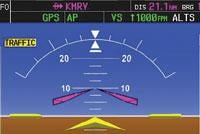 1) CHECK AND VERIFY USING THE PFD’S AUTOPILOT DISPLAY. Pilots, even airline pilots, new to a glass cockpit have been known to say, “What’s it doing now?” when referring to the autopilot doing something completely unexpected. If you’ve flown a glass-cockpit aircraft, then you’ve probably felt the same way at some point. The G1000 has a very straightforward way to check and verify what the autopilot is programmed to do. The Navigation Status box at the top of the PFD provides a complete picture of the next waypoint and the active and armed autopilot settings. Include the Selected Altitude box at the top of the altimeter ribbon for a comprehensive understanding of how the G1000’s autopilot is programmed. Green text means the procedure is active, while white text means that it’s armed and will automatically become active when appropriate. Always review this information before enabling the autopilot or changing mode (e.g., NAV, approach, etc.), and you’ll never be surprised.
1) CHECK AND VERIFY USING THE PFD’S AUTOPILOT DISPLAY. Pilots, even airline pilots, new to a glass cockpit have been known to say, “What’s it doing now?” when referring to the autopilot doing something completely unexpected. If you’ve flown a glass-cockpit aircraft, then you’ve probably felt the same way at some point. The G1000 has a very straightforward way to check and verify what the autopilot is programmed to do. The Navigation Status box at the top of the PFD provides a complete picture of the next waypoint and the active and armed autopilot settings. Include the Selected Altitude box at the top of the altimeter ribbon for a comprehensive understanding of how the G1000’s autopilot is programmed. Green text means the procedure is active, while white text means that it’s armed and will automatically become active when appropriate. Always review this information before enabling the autopilot or changing mode (e.g., NAV, approach, etc.), and you’ll never be surprised.
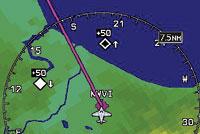 2) USE THE NAV RANGE RING FEATURE TO DISPLAY AN AIRCRAFT’S ESTIMATED GLIDING DISTANCE.The G1000 provides a visual indication showing how far your aircraft can glide if it loses engine power: If an airport is located within the ring, it should be reachable. The Nav Range Ring feature displays a ring showing the rough estimate of the gliding distance. First, calculate the gliding distance for the aircraft’s altitude. On the MFD’s Map Setup–Map Group window, turn the Nav Range Ring on, and the map will display an azimuth ring around the aircraft along with a number that’s the radius of the ring in miles. The distance is always 1⁄4th of the map range. Set the map scale such that the radius value is roughly the aircraft gliding distance, and you’ll have a gliding reference. It’s important to remember that the Nav Range Ring is circular and doesn’t take winds into account.
2) USE THE NAV RANGE RING FEATURE TO DISPLAY AN AIRCRAFT’S ESTIMATED GLIDING DISTANCE.The G1000 provides a visual indication showing how far your aircraft can glide if it loses engine power: If an airport is located within the ring, it should be reachable. The Nav Range Ring feature displays a ring showing the rough estimate of the gliding distance. First, calculate the gliding distance for the aircraft’s altitude. On the MFD’s Map Setup–Map Group window, turn the Nav Range Ring on, and the map will display an azimuth ring around the aircraft along with a number that’s the radius of the ring in miles. The distance is always 1⁄4th of the map range. Set the map scale such that the radius value is roughly the aircraft gliding distance, and you’ll have a gliding reference. It’s important to remember that the Nav Range Ring is circular and doesn’t take winds into account.
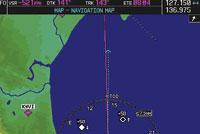
3) MANAGE YOUR DESCENT OR CLIMBS MORE EFFECTIVELY. Want to manage your descent or climb to arrive at a waypoint precisely on altitude? First, make sure you have the waypoint or the destination airport in the active flight plan. Configure the MFD’s Navigation Status bar fields to include Vertical Speed Required (VSR). From the MFD’s Flight Plan window, press the FMS knob and scroll using the large FMS knob to the Waypoint of Airport Altitude field. Next, enter the altitude you need to be at. If it’s a waypoint, simply enter the desired altitude at the waypoint and press Enter, and then press Enter again to accept MSL. If it’s an airport, then you need to apply a little judgment because the altitude you enter will be for overhead the airport waypoint. If, for example, you want to be at a pattern altitude of 1,200 feet MSL/800 AGL prior to entering the traffic pattern, then you’ll typically want to be at that altitude at least a mile before the airport. In this example, if you enter 800 MSL for overhead the airport, then you’ll be able to level at 1,200 feel MSL a short distance from the airport. Now all you have to do is match the VSR descent rate to arrive at the desired point at the desired altitude.
 4) MANAGE DIRECT TO NEARBY WAYPOINTS MORE EASILY. Sometimes you need to obtain or are given a clearance to a waypoint or airport that isn’t in the current flight plan. When given direct to a nearby airport, pressing the PFD’s NRST soft key will display the airport name, so you can select it and then press the Direct To button. It’s slightly more complex if you’re looking for intersections, VORs, etc. Use the MFD’s Nearest page. Find the page containing the type of waypoint you’re searching for (e.g., intersection), enable the cursor by pressing on the FMS knob and then scroll through the list to find the waypoint you desire. If you want to fly directly to the selected waypoint, press the Direct To button and then press Enter.
4) MANAGE DIRECT TO NEARBY WAYPOINTS MORE EASILY. Sometimes you need to obtain or are given a clearance to a waypoint or airport that isn’t in the current flight plan. When given direct to a nearby airport, pressing the PFD’s NRST soft key will display the airport name, so you can select it and then press the Direct To button. It’s slightly more complex if you’re looking for intersections, VORs, etc. Use the MFD’s Nearest page. Find the page containing the type of waypoint you’re searching for (e.g., intersection), enable the cursor by pressing on the FMS knob and then scroll through the list to find the waypoint you desire. If you want to fly directly to the selected waypoint, press the Direct To button and then press Enter.